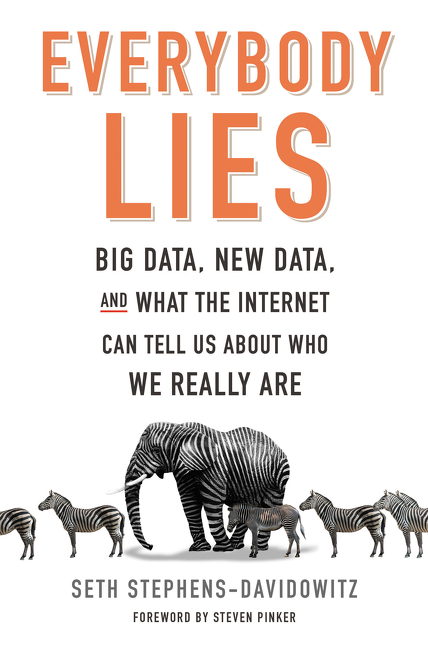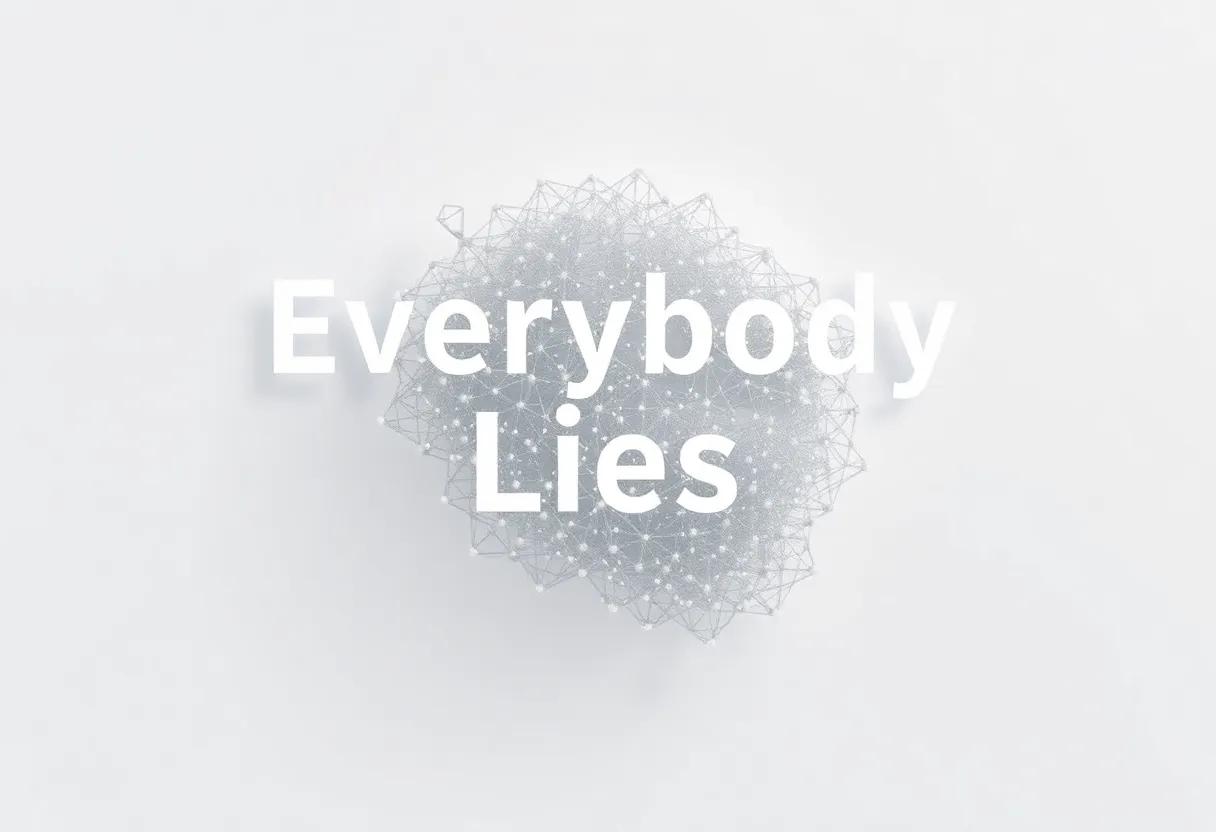In a world awash with facts, the quest to understand human behavior has taken an unexpected turn. “everybody Lies: Big Data, New Data, and What the Internet Can Tell Us About Who We Really Are” by Seth Stephens-Davidowitz delves deep into the digital footprints we leave behind, offering a fresh lens through wich to examine the complexities of mankind. This book invites readers to reconsider long-held assumptions by unveiling truths hidden within vast troves of online data-truths that conventional methods have often missed or obscured. In this review, we explore how Stephens-Davidowitz navigates the intersection of technology, psychology, and sociology to reveal insights about ourselves that are as surprising as they are enlightening.
Unlocking the Secrets of human Nature Through Big data Insights in Everybody Lies
In a world overflowing with information, big data acts as a mirror reflecting the hidden facets of human nature. By analyzing millions of online queries, social media interactions, and digital footprints, we uncover patterns that traditional studies often miss. This data-driven approach exposes the interesting paradoxes of human behavior-where honesty is scarce, but true intentions become visible through aggregated actions. It challenges the assumption that what peopel say matches what they do, revealing a truer picture beneath layers of social masking.
Consider the subtle ways big data unveils everyday contradictions:
- People search for health advice but simultaneously seek comfort in unhealthy habits.
- Publicly condemned behaviors remain widely practiced in private searches.
- Anonymous online activity provides a candid canvas of desires and fears rarely voiced aloud.
| Behavioral Aspect | Public Statement | Big Data Reveal |
|---|---|---|
| Diet | Commitment to healthy living | Frequent searches for junk food recipes |
| Social Attitudes | Denial of prejudice | High volume of biased search queries |
| Personal Insecurities | Maintains confident image | Extensive research on self-advancement tips |
Such insights invite readers to reconsider conventional wisdom about honesty, morality, and self-perception, positioning big data as an essential tool for unlocking the nuanced truths of human nature.
How Everybody Lies Challenges Traditional Assumptions About Human Behavior and Privacy
In an era where digital footprints are more revealing than ever, traditional beliefs about human behavior often fall short. Everybody Lies disrupts conventional wisdom by diving deep into big data searches, uncovering patterns that people would never admit to face-to-face. Rather than relying on what people *say* about themselves, the book leverages the raw, unfiltered truth embedded in online queries-highlighting a world where anonymity allows genuine desires, fears, and prejudices to surface. This challenges the assumption that humans naturally filter or censor their impulses, instead revealing that data can often paint a more honest portrait of society.
Privacy,once considered a shield against exposure,takes on a new dimension when explored through the lens of massive data sets. By analyzing millions of anonymized searches, the narrative illustrates how modern privacy is paradoxically both preserved and eroded; individual identities are hidden, yet collective behaviors emerge with striking clarity. Some key insights include:
- Contradictory behavior: People’s search histories frequently reveal conflicts between their stated values and their true interests.
- Hidden biases: Big data exposes societal prejudices that often go unspoken in public discourse.
- The illusion of control: Individuals believe they manage their digital footprints, but vast datasets can reconstruct deeply personal narratives.
| Traditional Assumption | Big Data Revelation |
|---|---|
| People understand and control their privacy | Anonymous data can still expose private thoughts and behaviors |
| Self-reports reflect true behavior | Search data reveals hidden desires and contradictions |
| Most people are honest in reporting actions | People frequently lie or censor, but data shows truth beneath |
Decoding Digital Footprints: The Power of Online Data in revealing Hidden Truths
In today’s digital age, every click, search, and share contributes to a vast mosaic of human behavior waiting to be deciphered. These digital footprints act as keys that unlock hidden patterns in our choices, desires, and even fears. From the seemingly trivial searches about medical symptoms to the carefully curated social media posts, online data offers an unprecedented lens into the complexities of the human psyche. Rather than relying solely on traditional surveys or interviews, big data allows us to observe raw, unsolicited truths-a dynamic shift that challenges preconceived notions about honesty and self-presentation.
Analyzing this ocean of data requires sophisticated tools and thoughtful interpretation. Consider the types of online behaviors that frequently enough reveal more than what’s spoken aloud:
- Anonymous searches: Candid glimpses into sensitive or stigmatized topics
- Product reviews: Genuine emotional responses and pain points
- Social interactions: Patterns in communication that hint at societal norms and conflicts
| Data Source | Insight Revealed | Behavioral Implication |
|---|---|---|
| Search engines | Secret anxieties | Unfiltered concerns often unchanged by social desirability |
| Social Media Posts | Social identity and peer influence | Public persona vs. private self |
| Online Marketplaces | Consumer trust levels | Brand perception and loyalty nuances |
Balancing Ethics and Exploration: Navigating Privacy Concerns in Big Data Research
In the realm of big data research, the quest to uncover hidden patterns of human behavior often walks a fine line between innovation and intrusion. While vast datasets unlock unparalleled insights, they also raise critical questions about individual privacy and consent. Researchers must champion clarity, ensuring that the data harvesting process respects personal boundaries and adheres to ethical guidelines. Leveraging anonymization techniques, such as, can shield sensitive information without sacrificing the richness of the analysis, fostering trust between data subjects and analysts alike.
Striking this balance requires a multi-faceted approach that encompasses:
- Robust data governance policies to regulate access and use
- Ongoing ethical review mechanisms adaptable to evolving technologies
- Active engagement with communities to explain research purposes and potential impacts
Below is a simple framework outlining the key elements and responsibilities involved in maintaining ethical standards during big data exploration:
| Element | Responsibility | Outcome |
|---|---|---|
| Data collection | Transparency & Consent | Informed participants |
| Data Storage | Secure Encryption | Protected information |
| Data Analysis | Bias Minimization | Objective insights |
the Surprising Patterns of Social Behavior Uncovered by Internet Search Analysis
Digging into the vast troves of internet search data reveals surprising layers of human nature that frequently enough remain hidden behind social conventions. When people search anonymously, their true curiosities, fears, and desires come to the surface, painting a candid portrait far removed from everyday conversations. Such as, topics around anxiety and personal relationships dominate search queries, suggesting that despite outward appearances, many struggle with deeply emotional challenges in private.This phenomenon underscores a stark contrast between public personas and internal realities, shedding light on how the digital age unearths genuine patterns of social behavior.
These insights can be categorized into several revealing trends, including:
- Taboo Interests: Subjects shrouded in stigma often see higher search volumes than daily, socially accepted topics.
- health Anxieties: Self-diagnosis searches outnumber actual doctor visits, highlighting a reliance on online information.
- Social Comparison: Individuals frequently query about others’ lives, fueling a culture of comparison and self-evaluation.
| Search Category | Common Emotions | Insight |
|---|---|---|
| Relationships | loneliness, Curiosity | High desire for connection despite social barriers |
| Health | Worry, Uncertainty | Seek comfort and confirmation through self-informed decisions |
| Privacy/Security | Fear, Suspicion | growing concern over personal data online |
Practical Applications of big Data Findings for Marketing, Policy Making, and Health
Big data uncovers patterns that are invisible to traditional research methods, revolutionizing the way marketers understand consumers. By analyzing search queries, social media chatter, and purchasing behavior, companies can tailor campaigns with laser precision, predicting trends before they fully emerge.Personalization becomes more than a buzzword-it transforms into a dynamic strategy,powered by insights gleaned from billions of data points. Marketers can also identify subtle shifts in sentiment and respond in real time, ensuring their messages resonate authentically with diverse audiences.
In the realm of policy making and health, big data acts as a compass, guiding decisions based on actual human behavior rather than assumptions. Governments can detect public sentiment and potential social issues early on, while health professionals benefit from timely, data-driven insights into disease outbreaks or risk factors. The value lies not only in the volume of information but in its ability to reveal the unexpected,such as hidden correlations or societal blind spots.
| Sector | Big Data benefit | Example |
|---|---|---|
| Marketing | hyper-targeted advertising | Customized product recommendations based on search history |
| Policy Making | Sentiment analysis for public opinion | Shaping social programs in response to cultural trends |
| Health | Early detection of outbreaks | Tracking flu trends from online symptom searches |
- Adaptive Strategies: Dynamic adjustments based on real-time data flow
- Behavioral Insights: Unveiling hidden patterns behind decision-making
- Risk Mitigation: Proactive identification of emerging challenges
Critical Reflections on Methodologies Used to Interpret Massive datasets Accurately
Delving into massive datasets demands more than just technical prowess; it requires a nuanced understanding of the limitations and biases embedded within data collection and analysis methodologies. While algorithms excel at detecting patterns, they often fall short in capturing the rich context behind human behavior. For instance, reliance on keyword frequency or search trends can obscure underlying motivations or cultural nuances that numbers alone can’t decode. This gap underscores the importance of blending quantitative data with qualitative insights,ensuring interpretations do not oversimplify or distort complex human realities.
Moreover, the sheer volume of data invites challenges related to noise filtering, sampling bias, and overfitting-all of which can skew conclusions if unchecked. Techniques such as machine learning offer powerful tools for pattern recognition but may inadvertently reinforce existing stereotypes if their training sets are unrepresentative. To balance this, researchers often employ triangulation, cross-validating findings across diverse sources and methodologies:
- Combining search query data with ethnographic studies
- incorporating temporal analysis to detect changing trends
- Utilizing demographic overlays to reveal hidden subpopulation behaviors
| Methodology | Strength | Potential Pitfall |
|---|---|---|
| Keyword Analysis | Quick trend spotting | Context loss |
| Machine Learning Models | Pattern recognition at scale | Bias amplification |
| Ethnographic methods | Rich cultural insights | Time-consuming, limited scale |
Lessons Learned from Everybody Lies About Data Reliability and Human Complexity
In the age of big data, there’s a common misconception that numbers tell an absolute truth. Yet, the reality is far more nuanced. Data reliability is often compromised by hidden biases, incomplete contexts, and the ever-shifting nature of human behaviors. What’s remarkable is how quantitative insights must be balanced with qualitative understanding-a reminder that data alone doesn’t capture the depth of human complexity. The lessons here challenge us to remain skeptical of surface-level conclusions and to appreciate the subtle interplay between statistics and real-world human emotions, choices, and contradictions.
This brings forward the necessity of embracing uncertainty as part of analyzing human behavior through big data. It’s not about finding definitive answers but recognizing patterns that highlight the intricacies behind what people reveal or withhold. Key takeaways include:
- Context matters: raw data without background loses meaning.
- People are paradoxical: actions often diverge from stated intentions.
- Biases permeate data: from sampling to interpretation.
- Transparency doubles insight: disclosing limits enhances trustworthiness.
| Data Challenge | Human Complexity Aspect |
|---|---|
| Incomplete datasets | Hidden behaviors & motivations |
| Sampling bias | Unequal representation of groups |
| Misinterpreted signals | Contradictory human emotions |
| Overgeneralization | Unique individual stories lost |
Recommendations for Researchers Seeking to Harness Big Data Without Bias
In the quest to decode human behavior via vast datasets,researchers must tread carefully to prevent skewed conclusions. Embracing transparency in data collection methods ensures that biases embedded in source material are identified early. Additionally, cross-referencing multiple data streams can mitigate the risk of echo chambers-a common pitfall when relying solely on singular platforms or demographics. Employing algorithmic fairness tools and regularly auditing code for unintended prejudices transforms raw numbers into genuine insights without the distortion of bias.
Beyond technical strategies, fostering a mindset of continual skepticism towards one’s own findings cultivates integrity. Researchers are encouraged to:
- Document assumptions: Clearly outline hypotheses and potential limitations.
- Engage diverse perspectives: Collaborate with interdisciplinary teams to challenge blind spots.
- Replicate studies: Validate patterns across different contexts and times.
| Key Principle | Implementation Tip | Benefit |
|---|---|---|
| Data Triangulation | Combine surveys, social media, and transaction logs | Reduces single-source bias |
| Blind Analysis | Mask sensitive variables during initial testing | Prevents confirmation bias |
| Continuous Auditing | Schedule regular bias checks in algorithms | Maintains long-term data integrity |
How Everybody Lies Encourages a More Nuanced View of Truth in the Information Age
In an era overwhelmed by digital information, the conventional binary understanding of truth versus falsehood often falls short. The book reveals that what people publicly claim and what they privately think or do frequently diverge dramatically. This discrepancy urges us to question surface-level data and encourages a deeper interpretation of reality, recognizing human complexity behind statistics. By harnessing big data-from search engines to social media trends-we begin seeing patterns of behavior as mirrors reflecting hidden desires, fears, and biases, rather than straightforward facts.
Adopting this nuanced approach challenges us to embrace ambiguity and multiplicity in understanding truth. Instead of seeking absolute answers, we learn to appreciate the subtleties expressed through incomplete or contradictory information. Key takeaways include:
- Contextualizing data: Truth varies with perspective and cultural nuances.
- The role of irony and contradiction: People’s online behavior is often paradoxical yet revealing.
- The importance of skepticism: Not all data points are accurate indicators of reality.
| Aspect | traditional View | Nuanced View |
|---|---|---|
| Truth | Absolute | Multifaceted and evolving |
| Data Interpretation | Literal | Context-dependent |
| User Behavior | Consistent | Contradictory yet insightful |
exploring the Impact of Big Data on Society’s Understanding of honesty and Deception
Big data has radically transformed how we decipher the intricate dynamics of honesty and deception in human behavior. by analyzing vast pools of digital footprints-from search queries to social media patterns-researchers uncover subtle truths that traditional methods frequently enough overlook. These insights challenge our preconceived notions, revealing that lying is not merely a moral choice but a deeply ingrained aspect of human nature influenced by context, incentives, and social pressures. The power of big data lies in its ability to:
- Detect patterns across millions of interactions that reveal hidden social norms
- Expose the complexity behind seemingly simple acts of honesty or deceit
- Enable predictive models that forecast dishonest behavior in various settings
Yet, this technological breakthrough also raises profound questions about privacy, trust, and ethics. As algorithms decode behaviors at scale, society must grapple with the implications of surveillance and consent. Below is a snapshot of how big data reshapes our understanding across different domains:
| Domain | Traditional View | Big Data Insight |
|---|---|---|
| Marketing | Consumers are honest about preferences | People often disguise true interests in surveys but reveal them in online behavior |
| Workplace | Deception is rare and deliberate | Microscopic daily white lies are common survival tools |
| Law Enforcement | Confessions and testimonies are reliable | Behavioral analytics detect subtle deception cues missed by human judgment |
the Author’s Journey and Expertise Behind the Groundbreaking work of Everybody Lies
At the heart of this transformative exploration lies an author whose unique blend of expertise bridges the worlds of technology, data science, and social observation. Leveraging years of experience working with massive datasets, the author pioneers a fresh methodology for dissecting human behavior-not through conventional surveys or interviews, but by mining the raw, unfiltered streams of online activity. This approach uncovers patterns and truths that traditional research frequently enough overlooks, revealing the hidden complexities beneath everyday choices and social trends.
Behind the groundbreaking insights are several critical pillars that define the author’s journey:
- Technical Mastery: Advanced skills in data analytics, machine learning, and natural language processing act as the foundation for interpreting vast troves of information.
- Curiosity-Driven Inquiry: A relentless pursuit to understand the subconscious impulses driving our digital footprints fuels the narrative.
- Multidisciplinary Perspective: Combining sociology, psychology, and computer science to create a holistic lens on human behavior.
| Expertise Area | Contribution to Research |
|---|---|
| Data science | Decoding behavioral signals in large datasets |
| Behavioral Psychology | Interpreting motivations behind digital actions |
| Sociology | Contextualizing societal impacts on data trends |
Everybody Lies invites us on a journey beneath the surface of our everyday narratives, revealing the hidden patterns that shape human behavior through the lens of big data. By unmasking our digital footprints, the book challenges assumptions and encourages a deeper understanding of truth in the modern age. Whether you’re a skeptic or a believer in data’s power, this exploration leaves you pondering how much of what we say-and do-remains unseen until the numbers speak. A compelling read that doesn’t just inform, but provokes reflection on the complex dance between privacy, honesty, and the stories we tell ourselves.







